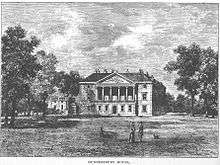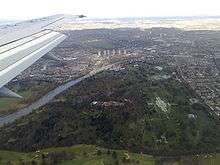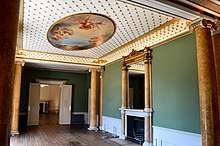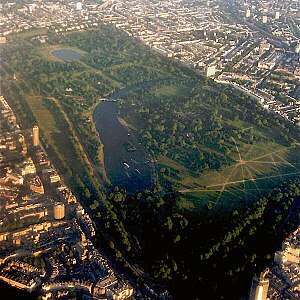Gunnersbury Park
Gunnersbury Park is a park in the London Borough of Hounslow between Acton, Brentford, Chiswick and Ealing, West London, England. Purchased for the nation from the Rothschild family, it was opened to the public by Neville Chamberlain, then Minister of Health, on 21 May 1926. The park is currently jointly managed by Hounslow and Ealing borough councils.[1] A major restoration project funded by the National Lottery was completed in 2018.
| Gunnersbury Park | |
|---|---|
The Large Mansion at Gunnersbury | |
| Ceremonial county | Greater London |
| Region | |
| Country | England |
| Sovereign state | United Kingdom |
| Post town | LONDON |
| Postcode district | W |
| Dialling code | 020 |
| Police | Metropolitan |
| Fire | London |
| Ambulance | London |
History
Origins

The name Gunnersbury derives from Gunylda, the niece of King Canute who lived there until her banishment from England in 1044. The manor, owned by the Bishop of London, was occupied by the Frowyk family in the 15th century; Sir Thomas Frowyk, Chief Justice of the Common Pleas was born there in 1460.
Early modern era
In the mid-17th century, Gunnersbury was acquired by Sir John Maynard, a lawyer and politician during the time of Cromwell.[2] It was he who in around 1663 built Gunnersbury House, a Palladian mansion modelled on the Villa Badoer, and designed by John Webb, the pupil and son-in-law of Inigo Jones. A map of Ealing dated 1777, shows the house in the north-east corner of the park, facing a horseshoe-shaped lake.
The house was bought in 1739 from Maynard's great grandson John Hobart, 1st Earl of Buckinghamshire by wealthy merchant and MP Henry Furnese, after whose death in 1756 it was sold to Princess Amelia, the daughter of George II.[3]
Daniel Defoe visited Gunnersbury in 1742. He wrote: "...(The Mansion) stands on an eminence, the ground falling gradually from it to the Brentford Road; from the Portico…you have an exceeding fine prospect of the County of Surrey, the river Thames…and a good prospect of London in clear weather…"
Princess Amelia
_by_Jean-Baptiste_van_Loo.jpg)
In 1760, the house and estate were purchased for Princess Amelia, favourite daughter of George II. Plans for her to marry Frederic (who later became Frederic the Great of Prussia) had come to nothing, and when her father died, Amelia had lost her apartments at St James's Palace. She took a house in Hanover Square and used Gunnersbury House and estate as a country summer retreat. Amelia – George III’s aunt, "that odd and hearty lady" – made Gunnersbury famous with her parties and political intrigues. The previous owner, Henry Furnese, had the grounds landscaped by William Kent in the 18th-century landscape style. Princess Amelia continued this, building a bathhouse in the grounds.
19th Century
After Amelia died in 1786, the estate had a number of owners. In 1788 it was acquired by Colonel Ironside, who sold it again in 1792 to a Walter Stirling. John Morley decided in 1801 to pull down the mansion and sell the land off piecemeal in 13 lots (the old house occupying Lot 2). The lots were eventually acquired by only two people, Alexander Copland (10 lots in 1802 and a further 2 in 1806), and Stephen Cosser (Lot 1 in 1802, sold to Major Alexander Morrison in 1807). Two separate estates were then established, each with its own new house. Copland, who bought 76 acres/30 hectares (most of the original grounds), was a builder and business partner of Henry Holland, and built the "Large Mansion" which was known, with its grounds, as "Gunnersbury Park". The "Small Mansion" was built virtually alongside in around 1806–1809, the builders evidently recognising the suitability of the position – an elevated terrace overlooking the horseshoe-lake near where the original mansion had stood. The small mansion and grounds were known as "Gunnersbury House".
Rothschilds
In 1835, the merchant and financier Nathan Mayer Rothschild purchased the Large Mansion and park shortly before he died. The Small Mansion and its grounds were acquired in 1889 by the Rothschilds from the Thomas Farmer family (who had owned it since 1828), finally reuniting the original estate. The Rothschilds extended Gunnersbury further, acquiring most of the Old Brentford Common Field to the west, as well as land to the north. An old clay-pit in the south-west, "Cole’s Hole" was landscaped to become the Potomac lake, and the tile-kiln beside it modified to become a boat-house disguised as a gothic folly.
20th century and public use
In 1925, following the death of Nathan's grandson Leopold de Rothschild, Leopold's wife, Maria, and son Lionel, sold the 200 acre/80 hectare Gunnersbury estate, which was entirely contained within the Brentford Urban District,[4] to the adjacent Ealing Borough Council and Acton Borough Council for £130,000. The land lay entirely outside their boundaries and the purchase was driven by snobbery. The "Queen of the Suburbs" did not want Brentford's municipal housing on its doorstep and the Mayor of Acton concurred, persuading her Borough Council to make it a joint purchase.
Following the Great War, there was a demand for house-building land. In addition the construction of the Great West Road, immediately south of the estate, was attracting modern industries along its "Golden Mile". Lionel Nathan de Rothschild had purchased an estate at Exbury, Hampshire in 1919 and was investing in a fine woodland garden there, so selling off the Gunnersbury estate presented an attractive opportunity. Disgruntled Ealing ratepayers wrote to the papers complaining about the burden on their rate bills. The adjacent Brentford and Chiswick Borough Council commented that since Ealing already had The Common and several other parks, not to mention Kew Gardens close by, another park would be unnecessary. They insisted that the greater part of the land should be used for housing, and opposed the loan of the purchase money to Ealing and Acton from the Ministry of Health. However, "civic pride and snobbery prevailed", and the Rothschilds sold Gunnersbury on condition that it was only to be used for leisure and recreation — although of the 200 acres/80 hectares, 13 acres were allowed to be used for building houses along the Popes Lane and Lionel Road boundaries of the estate to raise funds to pay off the loan. The transaction was very much welcomed by The Times, which commented that "...(Gunnersbury)... will be a place of health and happiness for many..." and that "...security against destruction seems to rest only with such places...acquired... with the help of landowners wealthy enough to be able, and public-spirited enough to be ready, to serve the public need".
When he opened the park, Neville Chamberlain "...rejoiced that the people had come into the possession of so magnificent and historical park..." He bemoaned the failure of earlier generations to recognise the need for open spaces in the towns and cities, when outdoor recreation was the privilege of the few. In the previous year, he said that the Ministry of Health had sanctioned loans of over £1.5M for the purchase of open space, but it was still not enough. Brentford and Chiswick relented the following year, joining Ealing and Acton in joint ownership and management of Gunnersbury. The park passed to the London Borough of Hounslow in 1965 and in 1967 the Gunnersbury Park Joint Committee with Ealing was set up.[1]
An adjoining area of Rothschild land just outside the Gunnersbury estate became the Gunnersbury Cemetery.
Today


The actions of the Rothschilds and the Ealing and Acton councils provided the local residents with the park that exists today. There is a substantial open area to the west bordering Lionel Road, which accommodates thirty-six football pitches in the winter.
The large mansion is now Gunnersbury Park Museum — opened in 1929 — a showcase for local history and archaeology, costume and fine art. Some memorabilia of the Rothschilds remain, including a number of their horse-drawn coaches.
There is a boating pond nearby, overlooked by a temple folly dating from 1760 — the only 18th-century building still standing in the park. Opposite this is a large Pitch and Putt next to some tennis-courts. There is an Orangery built in 1836 by Sydney Smirke, who designed the British Museum Reading Room, and the remains of a Gothic fantasy disguising the old stables. Close to the Orangery is what is left of the western half of the Horseshoe Lake – devoid of water now but planned for renewal.
On the east side of the park, adjacent to the boundary with the North Circular Road is where the Japanese water-garden used to be. It was laid out in 1901 as a site for Leopold de Rothschild's water lilies. This too is due for restoration. In the south western corner of the park is the Potomac fishing-lake complete with its boat-house folly.
Princess Amelia's most famous contribution to Gunnersbury was the bathhouse, a "battlemented Gothic building" still visible in the park near the eastern end of the small mansion. Current research shows that the visible building is 19th-century, although the 18th-century foundations of the original bathhouse have been identified under the floor.
Gunnersbury Park was a haven for small boys wanting to fly kites and model aeroplanes and float model boats in the pond, and avoid being evicted by vigilant park-keepers for riding their bikes. The large mansion is quite recognisable as the venue for the Police Exhibition in the climax of the Ealing Studios Comedy The Lavender Hill Mob, when the model Eiffel Towers were exposed as being made from stolen gold bullion. Recognising the cultural diversity of Hounslow and Ealing boroughs, since 2003 the London Mela has been held in Gunnersbury Park – a major celebration of culture from south Asia with live music, dance and fashion as well as market stalls and a selection of food and drink.
In 1991 the London-based indie band The Hit Parade released their single 'In Gunnersbury Park'; the song describes the failing relationship between songwriter J.Henry and his girlfriend who lived a short distance from the Park in Bollo Lane.[5]
In 2020, Gunnersbury Park and its museum served as the location of the music video of Liam Gallagher's single "Once".[6]
Historic buildings at risk
Despite this park and museum being within Greater London, and placed in the top 30% of registered parks in the country and thereby considered to be of national significance, the very high cost of building maintenance over the years has led to much decay. Not only the large mansion but 8 other structures have suffered neglect to the extent that they have been placed on the at risk sub-list compiled by the statutory body Historic England. The landscaping of the park itself is listed park to make a total of ten listings.[7]
Restoration

A multimillion-pound, four year restoration was completed in June 2018 with the reopening of the large mansion as a museum for Hounslow and Ealing. The restoration was funded by Ealing and Hounslow Councils, the Heritage Lottery Fund and Heritage England. Work was also carried out on the Orangery, the reinstatement of the Horseshoe Lake, Temple, Princess Amelia's Bath-house, the Gothic ruins and the Round Pond. A new cafe has been opened. Inside the mansion ground floor rooms have been restored with marble columns, the Four Seasons ceiling painting in the Long Gallery, the ornate fireplace in the Drawing Room and panoramic views of the 186 acre park. Upstairs rooms and the kitchens are also open.
The next phase of the Gunnersbury Regeneration Project will see one of the largest outdoor sporting facilities in London open to the public in spring 2019.[8]
Gallery
- The small mansion with the large mansion in the background to the left.
- The 18th-century temple.
 The boathouse on the Potomac.
The boathouse on the Potomac. The Orangery from the Horseshoe Pond after restoration.
The Orangery from the Horseshoe Pond after restoration.
References
- New approach for Gunnersbury Park Archived 16 July 2011 at the Wayback Machine, Hounslow London Borough Council, UK. Retrieved on 2 February 2008.
- John Maynard in Dictionary of National Biography.
- "Ealing and Brentford Manors". British History Online. Retrieved 1 October 2018.
- Great Britain Historical GIS / University of Portsmouth, Brentford UD (historic map). Retrieved 2 February 2008.
- "'In Gunnersbury Park'".
- Glynn, Paul (31 January 2020). "Liam Gallagher acts as 'King' Cantona's butler" – via www.bbc.co.uk.
- English Heritage (2009) Heritage at risk register: Gunnersbury Park and Museum. Accessed 13 November 2009.
- "Gunnersbury Park museum re-opens after transformation". London Borough of Hounslow. 19 June 2018.
Sources
- Gunnersbury Park and the Rothschilds, by Ann and James Collett-White, Heritage Publications, Hounslow Leisure Services, 1993, ISBN 1-899144-05-6, ISBN 978-1-899144-05-1.
- The Gunnersbury Park Museum 1927–1955 written and published by Ronald Gordon Lockhart Rivis, 1960.
- The Times 1925–1926.
- The Oxford Dictionary of National Biography.
- Ealing and Hanwell Past by Peter Hounsell, pub Historical Publications.
- Village London by Edward Walford, pub The Alderman Press.
- Information from the Gunnersbury Park Museum.
External links
| Wikimedia Commons has media related to Gunnersbury Park. |
- Friends of Gunnersbury Park & Museum website
- London Borough of Hounslow (2009)A guide to Gunnersbury Park today
- London Borough of Hounslow (2009)Gunnersbury Park
- London Borough of Hounslow Gunnersbury Park Museum
- English Heritage Risk Register (2009) Gunnersbury Park
- Museum of London:Ceramics and glass at Gunnersbury Park Museum Accessed 2009-11-13
- Victoria History of the Counties of England, Middlesex, Volume 7. A full account of the ownership of Gunnersbury from the 14th century
- Flickr images tagged Gunnersbury Park
- Old Gunnersbury House engraving of entrance front c1761
- 18th-century map showing the Park with the Palladian mansion and horseshoe lake

